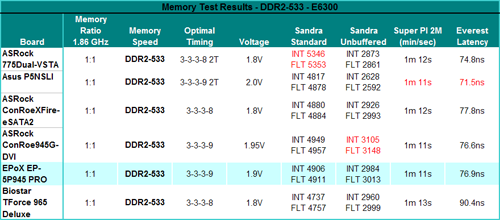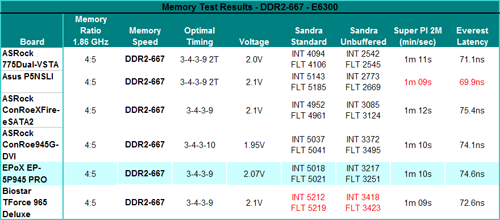EPoX EP-5P945 PRO: Budget 945P Performance
by Gary Key on September 11, 2006 4:45 AM EST- Posted in
- Motherboards
Test Setup
Our test setup for "budget motherboards" such as the EPoX is not the same configuration we use for performance motherboards. We are using the test configuration from our recent Core 2 Duo memory performance articles since we had a base of information with the E6300 and several competing Intel and VIA based motherboards. Also, this test configuration is well suited for this board's capabilities and would be considered a mainstream solution in regards to the overall system cost.
Our configuration was operated at a resolution of 1024x768 with high quality settings for each graphics benchmark. We are testing our motherboards at the fastest stable timings we can achieve and still pass our benchmark test suite. By increasing the memory voltage on the EPoX board we were able to run our Transcend modules at 3-3-3-9 at DDR2-533 and 3-4-3-10 at DDR2-667. Using memory ratios our CPU speed remains the same at 1.86GHz in the test platform, allowing us to get a good view of how memory bandwidth affects performance on these chipsets. Our memory settings were derived from extensive stress testing with a variety of applications. While certain settings that allowed lower latencies worked well with some applications, the final settings we arrived at had to work with all applications.
The Sandra Bandwidth Unbuffered memory performance of the EPoX board is the second highest of our group at DDR2-533 (1:1 ratio) and third highest at DDR2-667 (4:5 ratio). The Unbuffered scores of the EPoX board increase by 8% when going from DDR2-533 to DDR2-667 which is near the same increase found on the ASRock ConRoeXFire-eSATA2. However, the P965 equipped Biostar board scales at a rate of approximately 15%. The buffered memory scores are very competitive with the other solutions but we usually find these scores do not correlate well with real application performance.
In other synthetic testing, the EPoX board scores very well in our SuperPI 2M tests where it ties the Asus P5NSLI in the DDR2-533 results and places second in the DDR2-667 test. The latency results are average but improve upon the ASRock ConRoeXFire-eSATA2. A very good guide to understanding how the chipset, memory, and CPU relate to each other on Intel chipsets is located here.
Our test setup for "budget motherboards" such as the EPoX is not the same configuration we use for performance motherboards. We are using the test configuration from our recent Core 2 Duo memory performance articles since we had a base of information with the E6300 and several competing Intel and VIA based motherboards. Also, this test configuration is well suited for this board's capabilities and would be considered a mainstream solution in regards to the overall system cost.
| EPoX EP-5P945 PRO Performance Test Configuration |
|
| Processor: | Intel Core 2 Duo E6300 (1.86GHz, 2MB Unified Cache) |
| RAM: | 2 x 512mb Transcend JetRam DDR2-533 Tested at DDR2-533 3-3-3-9 1.90V |
| Hard Drive: | Seagate 320GB 7200RPM SATA2 16MB Buffer |
| System Platform Drivers: | Intel - 8.0.1.1002 |
| Video Cards: | 1 x EVGA 7600GS |
| Video Drivers: | NVIDIA 91.31 WHQL |
| CPU Cooling: | Cooler Master X-Dream P775 |
| Power Supply: | OCZ GameXstream 700W |
| Motherboards: | ASRock 775Dual-VSTA (VIA PT880Pro) ASRock ConRoeXFire-eSATA2 (Intel 945P) ASRock ConRoe945G-DVI (Intel 945P) EPoX EP-5P945 PRO (Intel 945P) |
| Operating System: | Windows XP Professional SP2 |
| . | |
Our configuration was operated at a resolution of 1024x768 with high quality settings for each graphics benchmark. We are testing our motherboards at the fastest stable timings we can achieve and still pass our benchmark test suite. By increasing the memory voltage on the EPoX board we were able to run our Transcend modules at 3-3-3-9 at DDR2-533 and 3-4-3-10 at DDR2-667. Using memory ratios our CPU speed remains the same at 1.86GHz in the test platform, allowing us to get a good view of how memory bandwidth affects performance on these chipsets. Our memory settings were derived from extensive stress testing with a variety of applications. While certain settings that allowed lower latencies worked well with some applications, the final settings we arrived at had to work with all applications.
 |
 |
| Click to enlarge |
The Sandra Bandwidth Unbuffered memory performance of the EPoX board is the second highest of our group at DDR2-533 (1:1 ratio) and third highest at DDR2-667 (4:5 ratio). The Unbuffered scores of the EPoX board increase by 8% when going from DDR2-533 to DDR2-667 which is near the same increase found on the ASRock ConRoeXFire-eSATA2. However, the P965 equipped Biostar board scales at a rate of approximately 15%. The buffered memory scores are very competitive with the other solutions but we usually find these scores do not correlate well with real application performance.
In other synthetic testing, the EPoX board scores very well in our SuperPI 2M tests where it ties the Asus P5NSLI in the DDR2-533 results and places second in the DDR2-667 test. The latency results are average but improve upon the ASRock ConRoeXFire-eSATA2. A very good guide to understanding how the chipset, memory, and CPU relate to each other on Intel chipsets is located here.










23 Comments
View All Comments
yacoub - Monday, September 11, 2006 - link
I find it... I dunno... strange that you break out a zero-anchor graph for the gaming tests when normally in reviews you guys use a tighter graph that does not start at zero and thus makes the difference between performance seem great.I guess what I find funny is that if you used that type of graph in all of your reviews, many parts reviewed would show their true improvement which is often very very little. This reviews shows how this board barely performs any worse than the other boards charted, yet if you'd used the older method of a graph starting at, say, '60' instead of '0' people would think OMG there's a HUGE difference.
Maybe what I'm trying to say is thanks for finally using a zero-anchored graph to show true performance delta instead of a zoomed in graph where the same charts would appear to have wide difference between part performance when they really don't.
yacoub - Monday, September 11, 2006 - link
Here's what I'm talking about in comparison if anyone is wondering:http://www.anandtech.com/mb/showdoc.aspx?i=2826&am...">http://www.anandtech.com/mb/showdoc.aspx?i=2826&am...
Gary Key - Monday, September 11, 2006 - link
Hi,We do listen (sometimes the message takes a while to sink in) and decided to do away with the non-zero based graph or even a zoom in in this case. Although we clearly stated our purpose with the non-zero based graphs and provided one (if clicked) it appeared from comments this offering was not satisfactory either. Hopefully, we will have an updated graphing engine in the near future so this type of information can be presented in a different fashion. Thanks for the comments!
:)